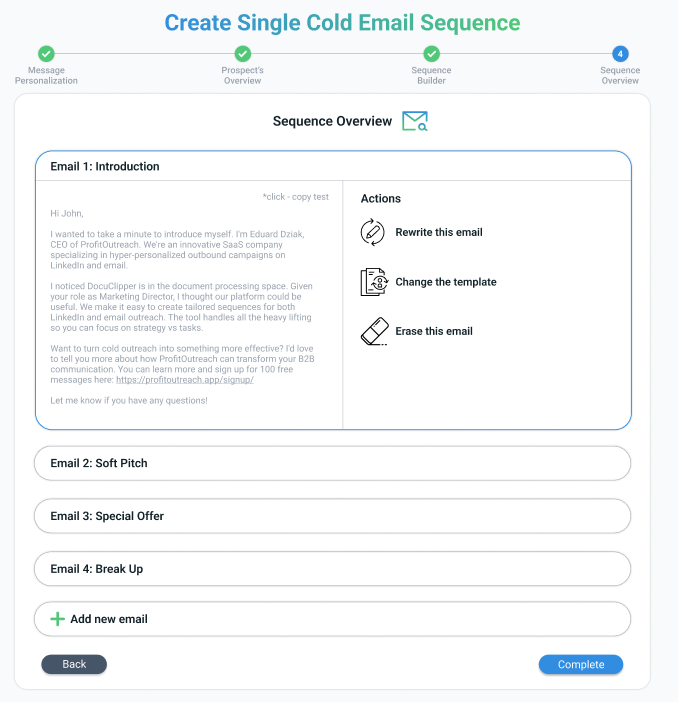In this article, you’re going to learn how to write effective cold email follow-ups that improve your engagement, response, and conversion rate!
All are backed by data.
Big promise?
I am ready to deliver!
Keep reading!
What is a Cold Email Follow-Up?
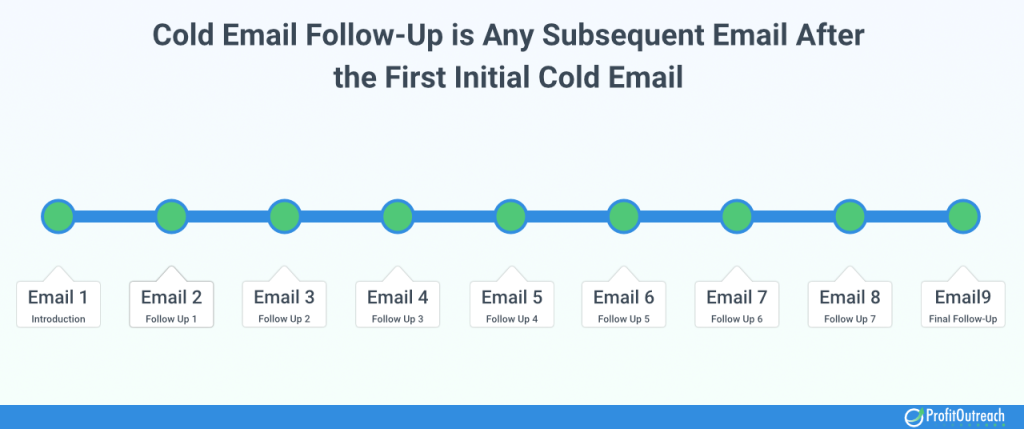
A cold email follow-up is any subsequent cold email sent after the initial outreach to a potential client or contact.
This type of cold email is crucial in maintaining communication and increasing your chances of receiving a response as well as continuously educating your prospect on your solution.
Often, your first email may get overlooked or forgotten, so a follow-up increases your chances of peaking prospect interest and taking the desired action.
Why Are Cold Email Follow-Ups Important?
Cold email follow-ups are crucial for your cold email campaign because they significantly increase your cold email response rates and cold email conversion rates, two essential cold email KPIs!
Cold email campaigns with follow-ups are 2-3 times more likely to get a reply.
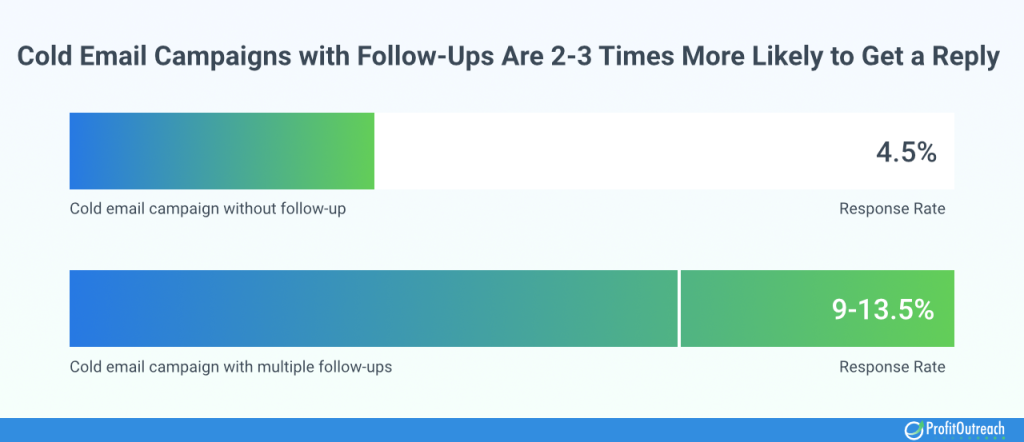
While individual reply rates below 2% might seem unimpressive, the cumulative effect of each follow-up can boost the combined reply rate above 20%. (Source)
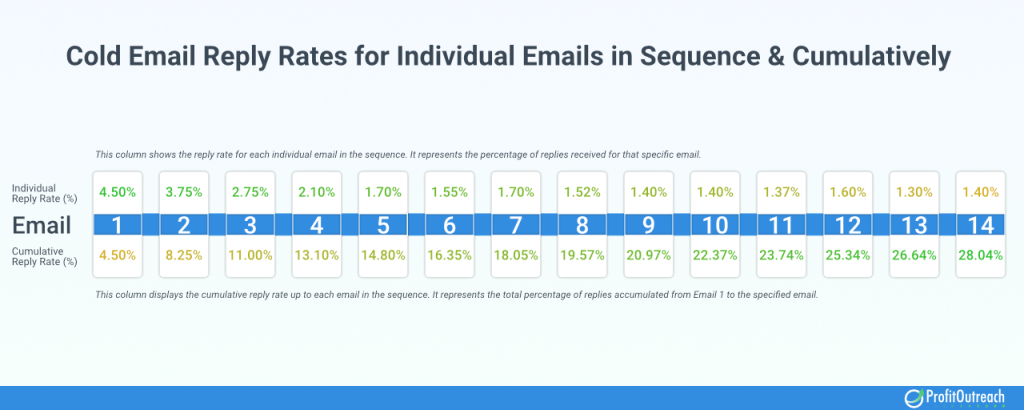
For example, if you send one email, you might see an average reply rate of 4.5%.
However, if you send up to 10 follow-ups, your total reply rate can reach as high as 22.37%.
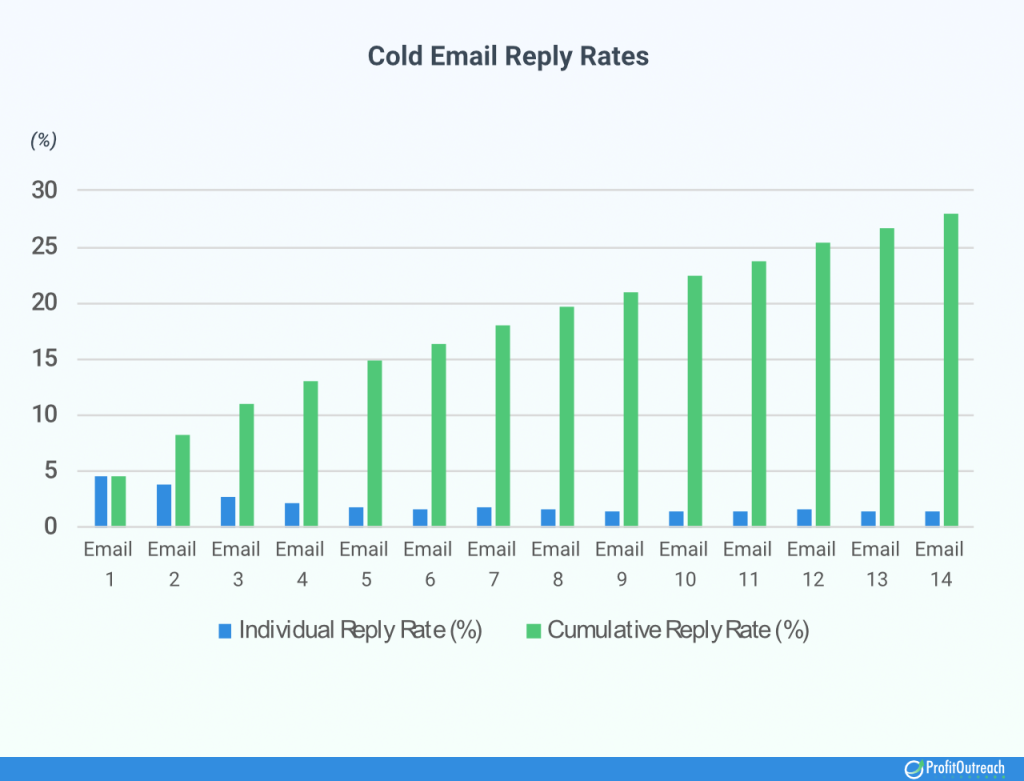
Consider a cold email campaign to 500 prospects: stopping after the first email with an average reply rate of 4.5% might yield around 22 replies.
Continuing with follow-ups can result in an average of 4-10 replies per follow-up, leading to over 100 replies by the end of the campaign.
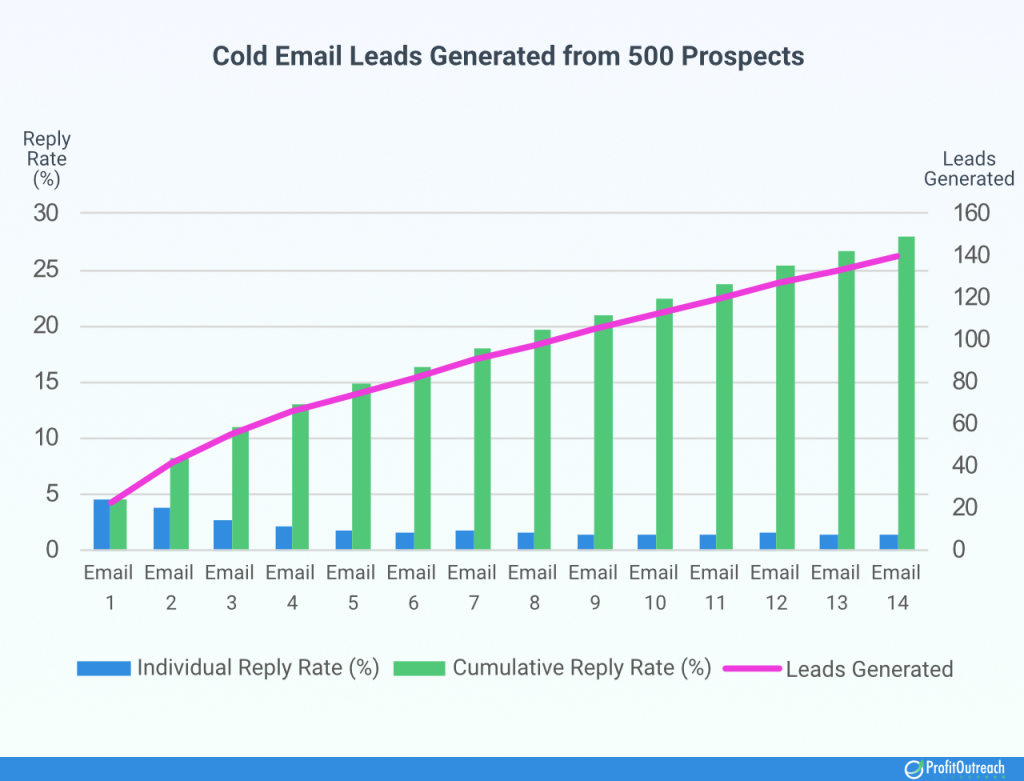
Sending up to 8 follow-up emails can double or even triple your conversion rates.
Furthermore, sending a first and second follow-up email increases your chances of getting a reply by 21% and 25%, respectively.
This shows the significance of cold email follow-ups and why your cold email campaign should have around 5-8 cold emails.
How to Write Cold Email Follow-Ups?
So now when we discuss the what’s and whys, let me share with you how you can write your own cold email follow-ups for any situation.
With my step-by-step guide, you will be able to write the entire cold email sequence regardless of whether you want to have 2 or 20 cold emails within your cold email sequence.
So here we go:
Step 1: Decide Your Target Audience
The first step in writing effective cold email follow-ups is to know who you want to write to.
Before you can start writing any cold email, you need to know who you will be writing to.
Without this step, it’s impossible to write effective cold email follow-ups that resonate with your audience and, most importantly, convert.
For example, at ProfitOutreach, we target marketing and sales professionals, each having hugely distinctive problems, objections, and needs from cold email generation software.
That means we need to segment our target audience in order to write relevant and effective cold email follow-ups that resonate with our target audience.
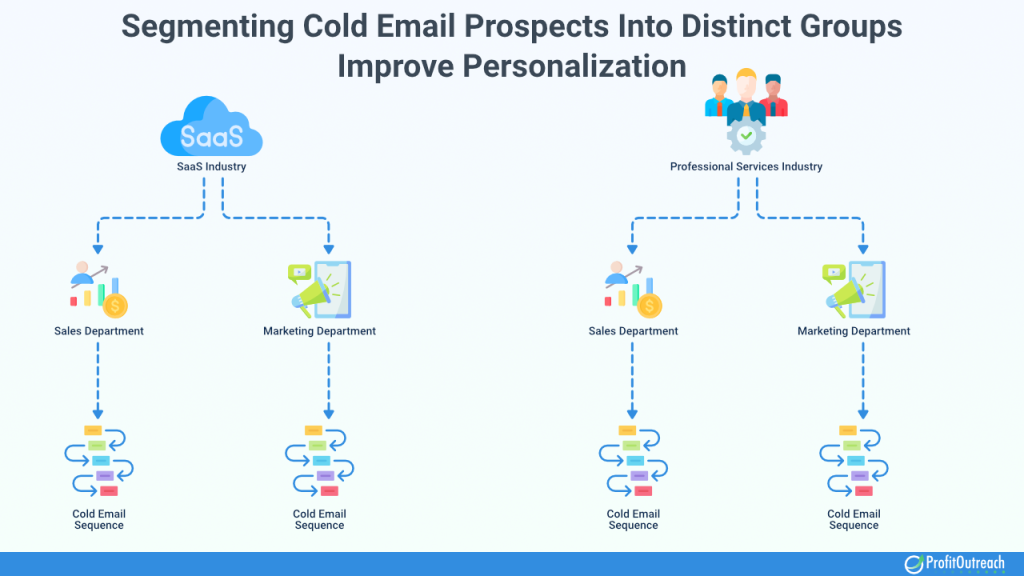
Therefore, it’s crucial you know for whom you’re writing your cold emails before you get started.
So, prepare your target audience that would most likely benefit from your solution.
Often, spying on your competitors can give you a good idea of who you should target first.
Step 2: Build Your Cold Email Sequence
The next step is to “build” your cold email sequence by selecting relevant cold email templates for your cold email sequence.
I like to think of a cold email sequence like a Lego set, and the templates are the individual pieces.
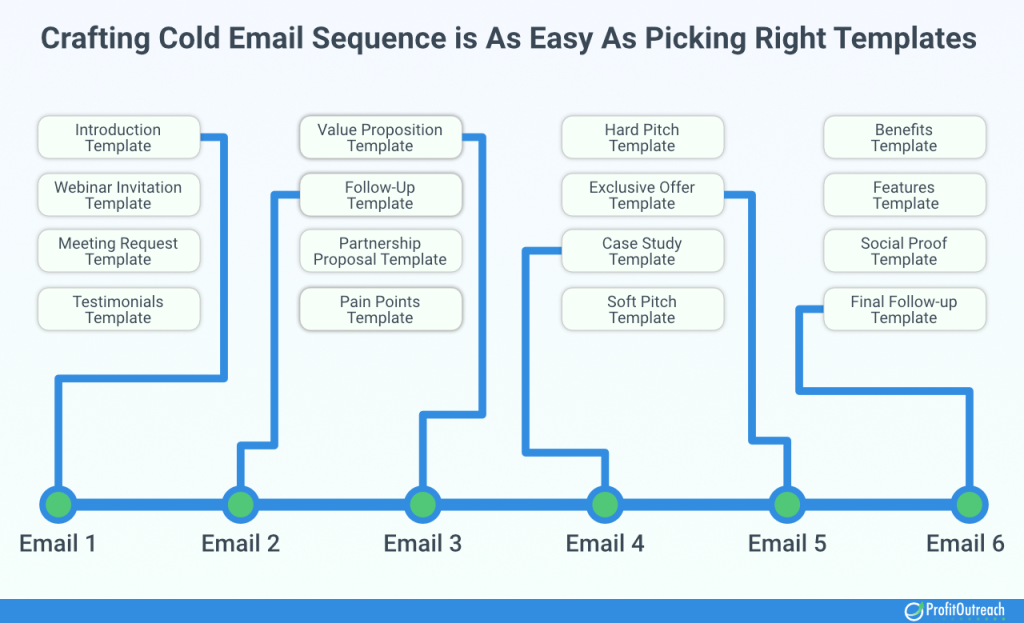
By using different cold email templates, you can create various sequences that align with your goals and objectives.
Each template serves a unique purpose, whether it’s introducing yourself, following up, sharing a testimonial, or making a final call to action.
So, familiarize yourself with these templates to see how they can fit together to form a cohesive and effective email sequence.
I recommend checking out our cold email template library for inspiration.
This resource will give you ideas on what cold email templates you can use to build up your cold email sequence.
BTW the ProfitOutreach cold email sequence generator has plenty of cold email templates you can choose from and we even write your entire hyper-personalized cold email sequence.
Step 3: Craft a Cold Email Subject Line
Alright, once you know what cold email follow-ups you will be crafting, then we can move on to the actual writing of cold emails.
From now on, we will focus only on the individual cold email follow-up.
And the first part will be crafting a cold email subject line for your cold email follow-up.
Arguably cold email subject line is the most important part of your cold email as 64% of cold email recipients decide to open or delete emails based on the subject line.
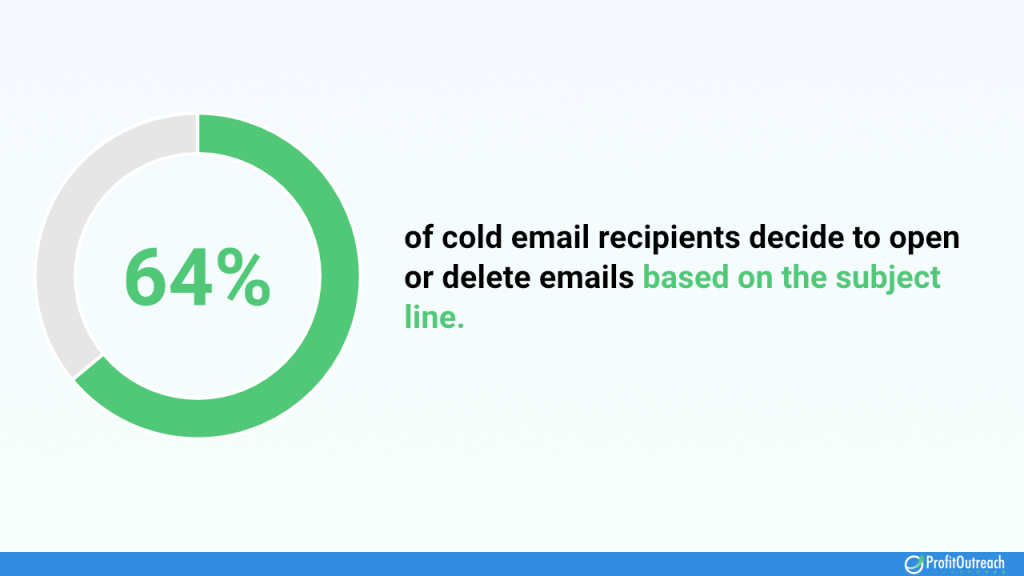
A subject line alone is enough to entice 47% of email recipients to open the cold email.
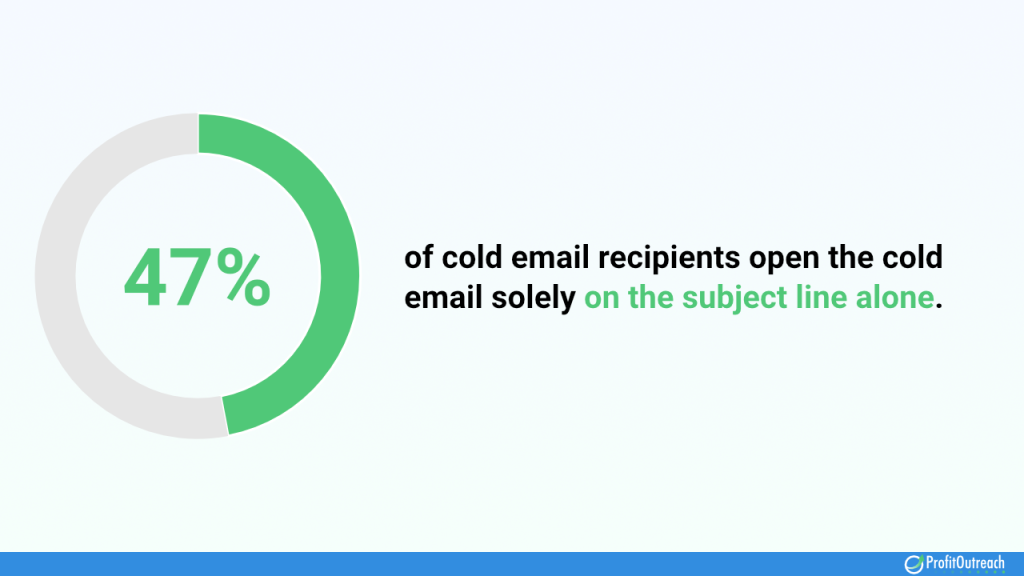
And there are many more reasons why you should spend at least the same amount of time crafting your subject line as crafting your actual cold email follow-up.
With that, here are some of the cold email subject line best practices to follow:
- Use numbers: Subject lines with numbers have a 17% higher open rate.
- Personalize your subject lines: Personalized subject lines are 26% more likely to be opened. E.g. add their name or company name.
- Keep it short: On average, email subject lines between 61-70 characters are read the most, at 17%. Email subject lines that have up to 5 words in them have an open rate of 16%.
- Add questions: Email subject lines with questions have a 50% higher open rate.
- Add emojis: Emoji in the Subject Line has an open rate of 13.65.
- Make it Relevant: Ensure that the subject line perfectly summarizes what is your cold email content about.
- If Can Provide Urgency: Give them a special deal that expires or limited space/time/product offer to prone them to take action.
- Avoid Spam Triggers
- A/B Testing: Test different subject lines to see which performs better and refine your approach accordingly.
- Be Clear and Concise: Ensure your subject line is straightforward and easy to understand at a glance.
- Highlight Benefits: If possible, mention a benefit or value proposition directly in the subject line.
- Use Action Words: Action-oriented words can encourage the recipient to take immediate action.
- Leverage Curiosity: Craft subject lines that pique the recipient’s curiosity without being misleading.
- Avoid Overuse of Caps and Exclamation Marks: These can make your email look spammy and decrease open rates.
Of course, this doesn’t mean you need to apply all these subject line best practices, but only those that are relevant to your cause and cold email template.
Step 4: Craft Personalized Email Content
The next step is to craft personalized cold email content.
Personalization is one of the best ways to improve your conversion and engagement rate regardless of whether it’s for cold email, email, or any other type of marketing.
In fact, 89% of marketers see a positive ROI when they use personalization in their campaigns.
And McKinsey reported that companies can generate as much as 40% more revenue from personalization.
And personalized cold emails achieve an impressive open rate of 29% and an outstanding click-through rate of 41% and personalized email content increases average cold email response rates by 32.7%. (cold email statistics)
Simply said, if you want to create effective cold email campaigns and follow-ups, you need to personalize your cold email content.
Now, creating cold email templates with variables can hardly be called personalization as 95% of the email content stays the same.
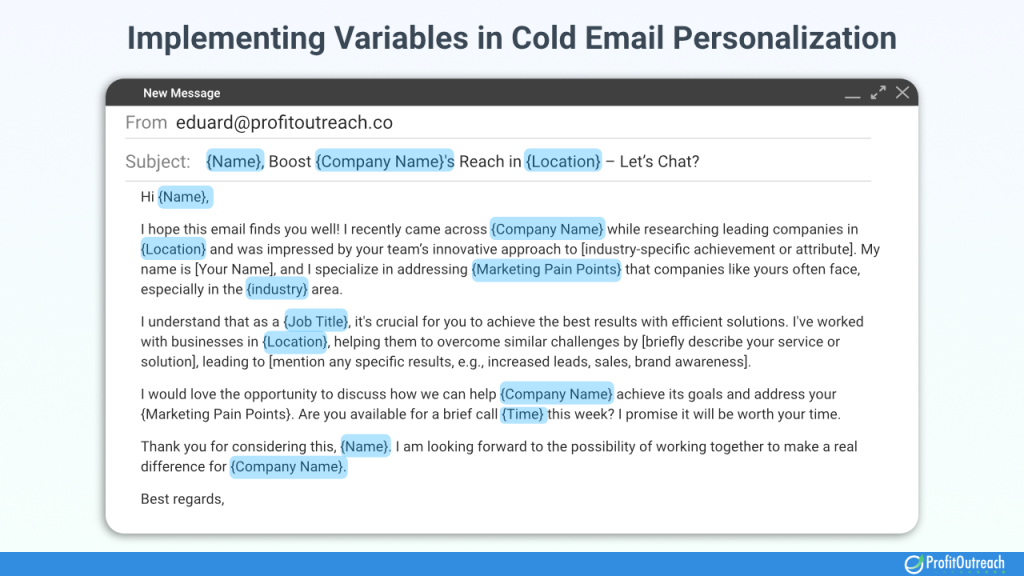
Plus, it often sounds like someone was trying too hard to make it relevant for hundreds or thousands of different prospects.
So, if you want to be really personalized you have three options.
- Using cold email templates with variables. As I said, these are not really personalized cold emails, and thus your engagement and conversion rate will suffer.
- Craft your cold email follow-ups based on the prospect’s personal information. This is not scalable, nor will it allow you to grow your business efficiently.
- Use personalized cold email generation software such as ProfitOutreach. ProfitOutreach takes all the important information about you, your offer, your business, and your prospects, and crafts hyper-personalized and unique cold email sequences for all your prospects.
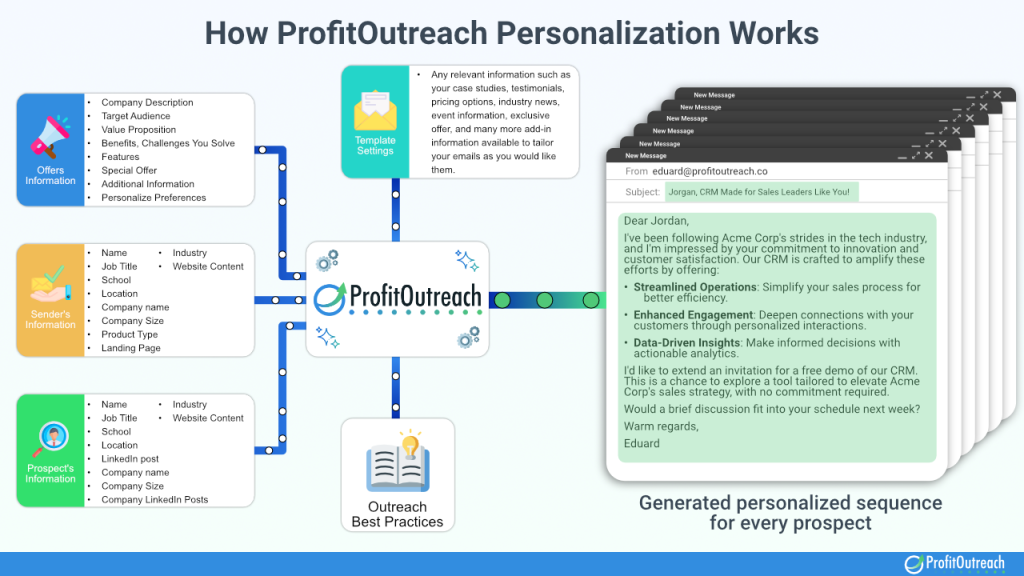
Now, if you’re not able to use a tool like ProfitOutreach, then you need to craft your personalized cold email follow-ups this way:
- Start with the opening line: The cold email opening line is the first text after greetings and is the most read part of your email. In 40-70 words, capture the recipient’s attention by mentioning a recent achievement, a shared connection, or something specific about their company.
- Move to the topic: Based on the cold email topic (template) you select, address it immediately after the opening line. Focus on the information you want to provide, such as testimonials, case studies, pain points you solve, benefits, etc. and don’t deviate from it. Remember only one information per email.
- Closing: Before moving to the CTA, sometimes a summary is helpful to put everything together in 20-40 words. Recap the key points and reinforce the value proposition.
Crafting personalized cold email content really depends on how much personal information you can use within the email while keeping it relevant.
It’s very hard to craft personalized cold emails if you need to use variables as those can get you only so far.
Therefore using advanced AI-powered cold email tools such as ProfitOutreach will boost your conversion rate and most importantly ROI from your cold email campaigns.
Step 5: Write Clear Cold Email CTA
The success of any cold email campaign is determined by how many prospects take the desired action, not just by how many open your cold email.
Your cold email’s Call to Action (CTA) must be perfectly designed to achieve this. Whether you want your prospects to click a link, sign up for a free trial, schedule a meeting, or simply start a conversation, the effectiveness of your campaign hinges on your CTA.
Therefore it’s essential that you tell your prospects what you want them to do.
However, it’s not only about “WHAT” you say, but “HOW” you say it.
And with CTAs this applies twice that much!
So here are some best tips for proper call email call to action to maximize conversions:
- Be Specific and Direct: Your CTA should clearly state the action you want the prospect to take. Avoid vague phrases and be explicit.
- Reduce Friction: Make the action simple and quick to complete. For instance, suggest a specific date and time for a call, include a calendar link for easy scheduling, or ask a straightforward question.
- Match Prospect Readiness: Tailor your CTA to your prospect’s readiness to act, ensuring that you don’t lose them to indecision or confusion.
- Personalize: Incorporate specific details about the prospect to make your CTA more relevant. For example, mention their name, company, or specific pain points.
- Create Urgency: Add urgency to your CTA to encourage immediate action. For example, highlight limited-time offers or deadlines.
- Use Action Words: Employ verbs that encourage action, such as “book,” “schedule,” “download,” or “join.”
- Write in First Person: Phrase your CTA from the prospect’s perspective. For example, “Yes, I’d like to learn more” or “Schedule my demo.”
Remember an effective CTA motivates your prospects to take the next step, moving them closer to becoming customers.
Step 6: Proofread & Remove Spam Words
And the last step of writing effective cold email follow-up (s) is to proofread your cold emails and remove any fluff, correct mistakes, and remove any spam words.
Generally, you want to keep your cold email follow-up as short as possible while maintaining the information intact and by reading your cold emails again, you will be able to shorten it and remove any fluff.
Furthermore, you want to remove as many spam words within your cold email follow-up.
Spam words can trigger filters, causing your email to end up in the recipient’s junk folder, reducing your chances of a response.
Words such as “free,” “guarantee,” “urgent,” “winner,” “act now,” “limited time,” “100% free,” and “click here” are often seen as spammy.
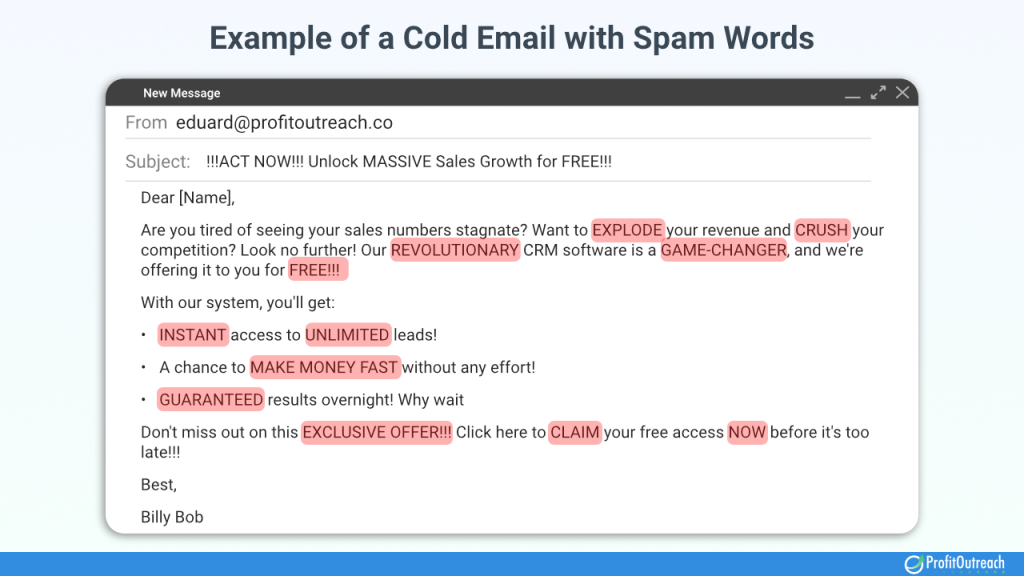
You can use a free email spam word checker to help you validate your cold emails before sending them.
However!
It doesn’t mean you cannot have a single “spam” word within your cold email.
It’s totally fine to have a couple of “spam” words within your cold email as long as they accurately describe the content and message you want to pass over to your prospects.
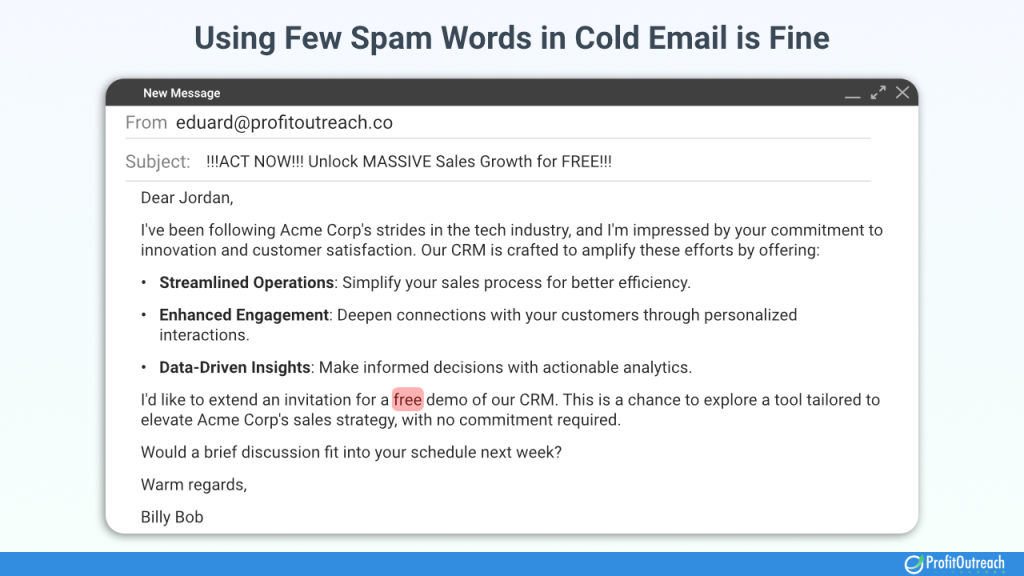
So, shorten your email, remove any spam words that can be easily removed without negatively affecting the copy of your cold email follow-up, and fix any grammatical errors.
And you’re ready to send your cold email follow-ups!
Learn more about the differences between spam and cold email and how to avoid end-up in the spam folder.
How Many Cold Email Follow-Ups Should You Send?
The ideal number of cold email follow-ups is between 4 and 9. Sending too few follow-ups may not give your prospects enough opportunities to respond while sending too many can overwhelm them and increase the risk of your emails being flagged as spam.
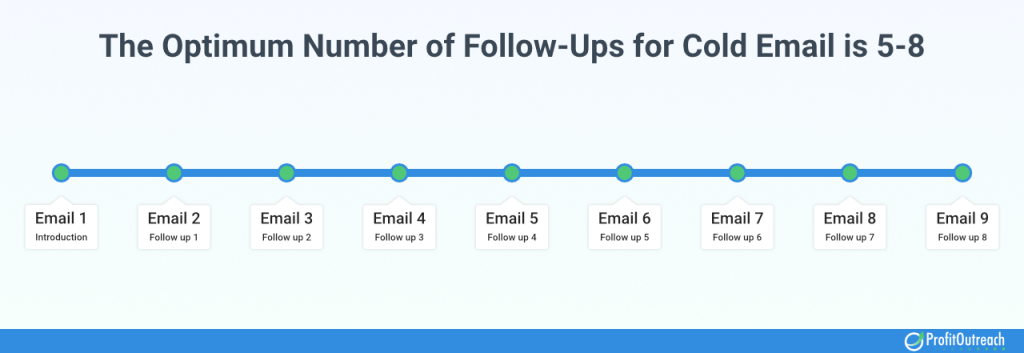
Based on research shows that the reply rates increase with each follow-up email sent.
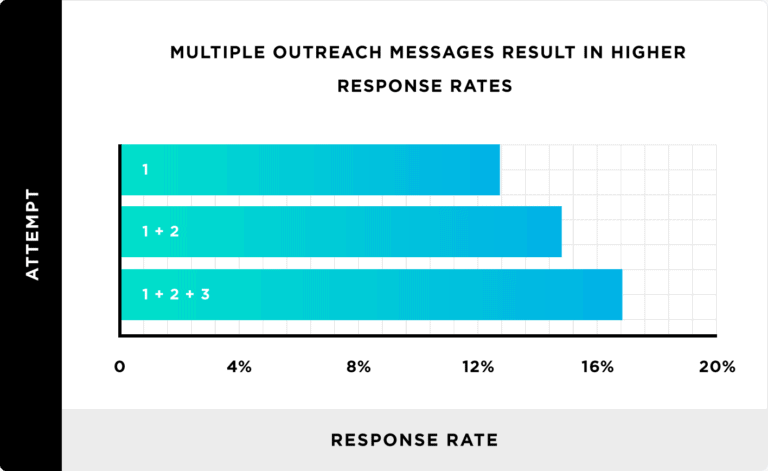
That same outcome was reached by Lemlist as well.
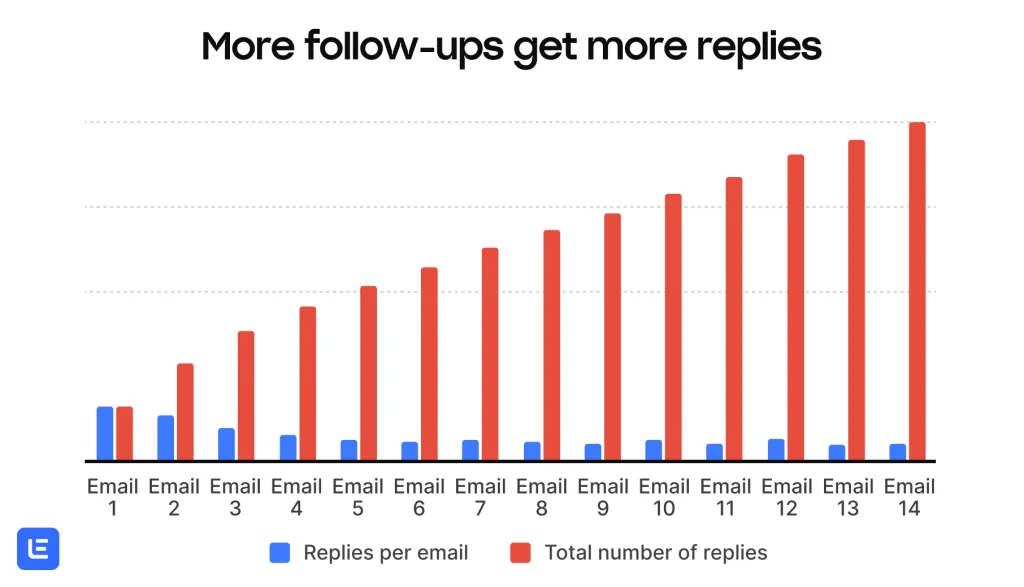
So, as I already mentioned, generally the more cold email follow-ups you can send, the better outcome you can expect.
But, I also believe knocking at the same door for far too long is a waste of your resources and cold email quota.
So, a cold email sequence with up to 10 cold emails should be the number. Ideally, I believe the number is 6 cold email follow-ups.
Also, read about how many cold emails to send per day.
How Long to Wait Between Cold Email Follow-Ups?
Recent studies show that, on average, it takes almost 12 hours to respond to an email.
However, this includes all emails from coworkers, partners, customers, vendors, etc. Responding to a cold email is often at the bottom of the priority list for each of your prospects.
According to a Forbes study, after 48 hours, there’s little chance of a response, and there’s a 90% likelihood that you’ll get a reply within a day or two if the recipient is going to respond.
Therefore, scheduling your cold email follow-ups 3-5 days apart is ideal. I recommend scheduling the first two cold email follow-ups 3 days apart and then gradually increasing the time between follow-ups.
7 Best Cold Email Templates for Follow-Ups
In this section, I am going to share with you one of my favorite as well as commonly used cold email templates for follow-ups by our customers:
1. Cold Email Follow-Up Template
A Cold Email Follow-Up Template is essential for re-engaging prospects who haven’t responded to your initial outreach.
The best time to use this template is typically 3-5 days after the first email, ensuring your message is still fresh in the recipient’s mind.
This template is ideal for any company looking to nurture leads, especially in B2B sales, SaaS, and marketing industries.
The goal of this template is to remind the prospect of your initial email, reiterate the value you offer, and prompt a response.
This template is effective because it demonstrates persistence and interest without being too pushy.
It provides an opportunity to clarify any doubts the prospect may have had about your initial email and positions you as attentive and committed to providing value.
Cold Email Follow-Up Template:
Subject: Quick Follow-Up on My Previous Email
Hi {First Name},
I hope this message finds you well. I wanted to follow up on the email I sent last {Day of the Week} regarding {specific topic or benefit your product/service offers}.
I understand you might be busy, so I wanted to briefly reiterate how {Your Company} can help {Prospect’s Company} achieve {specific goal}.
To recap, {briefly summarize the main point of your initial email}. Many of our clients, such as {Client A} and {Client B}, have seen significant improvements in {specific area}, and I believe we can offer the same value to {Prospect’s Company}.
I’d love to discuss this further and answer any questions you may have. Are you available for a quick call this week?
Please let me know a convenient time, or feel free to book a slot directly on my calendar here: [Insert Calendar Link].
Looking forward to your response.
Best regards,
{Your Full Name}
{Your Position}
{Your Contact Information}
2. Cold Email Social Proof Template
The Cold Email Social Proof Template leverages testimonials, case studies, or notable client successes to build credibility and trust with your prospects.
The best time to use this template is after your initial email, especially if the prospect hasn’t responded yet and might need additional convincing.
Companies in competitive industries, such as SaaS, digital marketing, and consultancy, will find this template particularly useful.
The goal is to showcase the success of other clients to persuade the prospect that your product or service is trustworthy and effective.
This template is effective because it provides concrete evidence of your value proposition. By highlighting real-world examples of satisfied clients, you reduce skepticism and increase the likelihood that the prospect will see the potential benefits for their own business.
Cold Email Social Proof Template:
Subject: See How We Helped {Client’s Name} Achieve {Specific Result}
Hi {First Name},
I hope you’re doing well. I wanted to follow up and share some success stories from companies like {Prospect’s Company} that have benefited from our services.
For example, {Client’s Name} was able to achieve {specific result} within {time frame} by using {Your Product/Service}. They faced challenges similar to those you might be experiencing, such as {specific pain point}. After implementing our solution, they saw significant improvements, including {specific benefits or metrics}.
Here’s what {Client’s Name} had to say:
“{Client’s Testimonial}.”
We believe that {Prospect’s Company} could see similar success with our help. I’d love to discuss how we can tailor our solution to meet your specific needs.
Are you available for a brief call this week? You can book a time directly on my calendar here: [Insert Calendar Link].
Looking forward to hearing from you.
Best regards,
{Your Full Name}
{Your Position}
{Your Contact Information}
3. Cold Email Value Proposition Template
The Cold Email Value Proposition Template focuses on clearly communicating the unique benefits and value your product or service offers.
This template is best used after the initial email, particularly if the prospect has shown some interest but hasn’t yet taken action. Companies across various sectors, including technology, healthcare, and finance, can benefit from this approach.
The goal of this template is to succinctly present the core value you bring to the prospect’s business, highlighting how you can solve their specific pain points or improve their current situation.
This template is effective because it centers on what matters most to the prospect—the value they will receive.
By clearly articulating your value proposition, you make it easier for the prospect to understand the benefits and make a decision.
Cold Email Value Proposition Template:
Subject: Unlock {Specific Benefit} for {Prospect’s Company}
Hi {First Name},
I hope you’re having a great day. I wanted to follow up on my previous email and highlight how {Your Company} can help {Prospect’s Company} achieve {specific benefit}.
At {Your Company}, we specialize in {briefly describe your product/service}, which has helped companies like {Client A} and {Client B} to {achieve specific result}.
Here’s how we can add value to {Prospect’s Company}:
- Benefit 1: {Describe how it addresses a pain point or need}
- Benefit 2: {Explain how it improves efficiency, saves money, etc.}
- Benefit 3: {Highlight any unique features or advantages}
For instance, {Client’s Name} experienced a {specific percentage} improvement in {specific area} after implementing our solution. We believe {Prospect’s Company} could see similar results.
Would you be available for a quick call this week to discuss how we can tailor our solution to meet your needs?
You can book a time directly on my calendar here: [Insert Calendar Link].
Looking forward to your response.
Best regards,
{Your Full Name}
{Your Position}
{Your Contact Information}
4. Cold Email Exclusive Offer Template
The Cold Email Exclusive Offer Template is designed to entice prospects with a limited-time or special offer that adds a sense of urgency and exclusivity.
The best time to use this template is after your initial email, especially if the prospect has shown some interest but hasn’t yet taken action.
This template is particularly effective for companies in e-commerce, software, and subscription-based services.
The goal is to motivate the prospect to act quickly by presenting a valuable offer they can’t resist.
This template is effective because it leverages scarcity and urgency, which are powerful psychological triggers.
By offering something exclusive, you make the prospect feel special and encourage them to take immediate action.
Cold Email Exclusive Offer Template:
Subject: Exclusive Offer Just for You, {First Name}!
Hi {First Name},
I hope you’re doing well. I wanted to follow up on my previous email and extend a special offer exclusively for {Prospect’s Company}.
For a limited time, we’re offering {specific offer} to select businesses like yours. This exclusive offer includes:
- Benefit 1: {Describe the specific feature or discount}
- Benefit 2: {Explain how it adds value or solves a problem}
- Benefit 3: {Highlight any additional bonuses or incentives}
For example, companies like {Client A} have taken advantage of this offer and achieved {specific result}. We believe {Prospect’s Company} could see similar benefits.
This offer is only available until {specific deadline}, so don’t miss out on this opportunity to enhance your {specific area} with our {product/service}.
Are you available for a quick call this week to discuss this exclusive offer? You can book a time directly on my calendar here: [Insert Calendar Link].
Looking forward to hearing from you.
Best regards,
{Your Full Name}
{Your Position}
{Your Contact Information}
5. Cold Email Soft Pitch Template
The Cold Email Soft Pitch Template is designed to introduce your product or service in a subtle and non-intrusive manner.
The best time to use this template is after your initial email when you want to maintain a conversational tone while still highlighting the benefits of what you offer.
This template is ideal for companies in consulting, professional services, and SaaS industries. The goal is to initiate a dialogue without being overly aggressive, making the prospect feel comfortable and valued.
This template is effective because it avoids the hard-sell approach, which can be off-putting to many prospects.
Instead, it gently introduces the value you provide, encouraging a natural conversation that can lead to a deeper engagement.
Cold Email Soft Pitch Template:
Subject: Quick Thought on {Prospect’s Company} and {Your Company}
Hi {First Name},
I hope this email finds you well. I wanted to follow up on my previous email and share a quick thought about how {Your Company} might be able to support {Prospect’s Company} in achieving {specific goal}.
We specialize in {briefly describe your product/service} and have helped companies like {Client A} and {Client B} to {achieve specific result}. I believe there might be an opportunity for us to assist you in {specific area} as well.
For example, our clients have seen benefits such as:
- Benefit 1: {Describe a relevant benefit}
- Benefit 2: {Explain another relevant benefit}
- Benefit 3: {Highlight an additional benefit}
I’d love to explore this further with you. Are you open to a brief chat sometime this week to discuss how we can potentially collaborate? If so, feel free to reply with a convenient time, or you can book a slot directly on my calendar here: [Insert Calendar Link].
Looking forward to your thoughts.
Best regards,
{Your Full Name}
{Your Position}
{Your Contact Information}
6. Cold Email Webinar/Event Invite Template
The Cold Email Webinar/Event Invite Template is designed to invite prospects to join a webinar or event that provides value and insights related to your product or service.
The best time to use this template is after your initial email, especially if the prospect has shown interest but hasn’t yet taken action.
This template is perfect for companies in industries like technology, education, and marketing. The goal is to engage prospects by offering them an opportunity to learn more about a relevant topic, showcasing your expertise, and building trust.
This template is effective because it offers prospects a chance to gain valuable knowledge without a direct sales pitch.
It positions your company as a thought leader and provides a platform for deeper engagement.
Cold Email Webinar/Event Invite Template:
Subject: Exclusive Invite: Join Our Webinar on {Webinar Topic}
Hi {First Name},
I hope you’re doing well. I wanted to follow up on my previous email and extend a special invitation to our upcoming webinar, “{Webinar Title}.”
This webinar will cover {briefly describe the main topic and benefits}, and it’s designed to help companies like {Prospect’s Company} achieve {specific goal or solve a specific problem}.
During the session, we’ll discuss:
- Topic 1: {Brief description}
- Topic 2: {Brief description}
- Topic 3: {Brief description}
You’ll also have the opportunity to ask questions and interact with our experts, including {Speaker’s Name}, who has extensive experience in {relevant field}.
The webinar is scheduled for {date and time}, and you can register for free using the link below:
[Insert Registration Link]
We believe this event will provide valuable insights and actionable strategies for {Prospect’s Company}. I hope you can join us!
Please feel free to reply if you have any questions or need more information.
Looking forward to seeing you at the webinar.
Best regards,
{Your Full Name}
{Your Position}
{Your Contact Information}
7. Cold Email Final Follow-Up Template
The Cold Email Final Follow-Up Template is your last attempt to engage a prospect who hasn’t responded to previous emails.
The best time to use this template is after you’ve sent multiple follow-ups and haven’t received a reply.
This template is suitable for any company looking to give a final nudge to their prospects, especially in sales, SaaS, and B2B industries.
The goal is to make a final appeal, emphasizing the value and urgency while being respectful of the prospect’s time and decision.
This template is effective because it combines a polite tone with a clear message that this is your final attempt to reach out.
It conveys respect for the prospect’s time while making one last effort to capture their interest.
Cold Email Final Follow-Up Template:
Subject: Final Follow-Up: Any Thoughts on Our Proposal, {First Name}?
Hi {First Name},
I hope you’re well. This is my final follow-up regarding our previous discussions about {specific topic or benefit your product/service offers}.
I understand that you’re busy and wanted to respect your time, so this will be my last attempt to reach out.
To recap, {Your Company} specializes in {briefly describe your product/service}, and we’ve helped companies like {Client A} and {Client B} achieve {specific result}.
We believe that {Prospect’s Company} could benefit significantly from our solution.
Here are a few key benefits we offer:
- Benefit 1: {Describe how it addresses a pain point or need}
- Benefit 2: {Explain how it improves efficiency, saves money, etc.}
- Benefit 3: {Highlight any unique features or advantages}
If you’re still interested in exploring this further, I’d love to schedule a quick call at your convenience. You can book a time directly on my calendar here: [Insert Calendar Link].
If now is not the right time, I completely understand and appreciate your consideration. Please feel free to reach out in the future if your circumstances change.
Thank you for your time, and I wish you all the best.
Best regards,
{Your Full Name}
{Your Position}
{Your Contact Information}
Best Practices for Cold Email Follow-Ups
Lastly, I want to share some best practices for cold email follow-ups and summarize this article into actionable steps.
I’ll recap some of the tips and best practices mentioned earlier, and add a few more to ensure you achieve the best results with your cold emails.
Here are the tips, tricks, and best practices for cold email follow-ups:
- Ideal Number and Timing of Follow-Ups: Send between 4-9 follow-ups for the best results, ideally around 6. Schedule follow-ups 3-5 days apart, starting with shorter intervals and gradually increasing.
- Decide Your Target Audience: Know who you’re writing to and segment your audience based on their specific needs and objections.
- Build Your Cold Email Sequence: Use various cold email templates to create a cohesive sequence that aligns with your goals.
- Craft a Compelling Subject Line: Use numbers, personalization, questions, emojis, and action words. Keep it short, clear, and relevant. Avoid spam triggers and conduct A/B testing.
- Craft Personalized Email Content: Personalize your emails based on audience segmentation and relevant research. Use tools for hyper-personalization or manually craft messages tailored to individual prospects.
- Write a Clear CTA (Call to Action): Be specific, direct, and reduce friction in your CTA. Match the prospect’s readiness, create urgency, and use action words.
- Proofread and Remove Spam Words: Keep emails concise and correct any mistakes. Remove or minimize spam words to avoid triggering filters.
- Learn Some Copywriting Tips: In a cold email, copywriting plays a crucial role as you need to provide information in a short, relevant, and catchy manner to win over your prospects.
- Keep the emails short: 90-150 words. Concise messages are more likely to be read and responded to.
- Each follow-up should be different: Ensure that each follow-up provides different information such as case studies, solving pain points, pointing out benefits, or offering new insights.
- Always run A/B Tests: With subject lines, types of emails, CTAs, and other elements to optimize performance.
- Focus on Deliveribility: Cold email deliverability is essential for your cold email follow-ups so ensure you apply the deliverability best practices.
That’s all that I have for you for now, BUT, I am consistently adding new best practices here so make sure to come back every 6 months and read this article to learn more about best practices for cold email follow-ups.
You can put it into your calendar, I can wait before I carry one with this article.
ProfitOutreach Writes 100% Unique & Hyper-Personalized Cold Email Follow Ups
ProfitOutreach enables you to design personalized outreach sequences effortlessly using real prospect data like names, company names, job titles, industries, locations, company sizes, and company website content.
By leveraging this detailed information, you can create highly targeted and impactful messages. ProfitOutreach’s precision personalization enhances engagement and response rates, making each message feel unique and relevant to the recipient.
Our platform’s user-centric design ensures ease of use, allowing anyone to build and personalize effective outreach campaigns, regardless of technical skill level. Choose ProfitOutreach for its focused solutions, extensive template selection, and scalability, perfect for businesses of all sizes aiming to streamline their outreach efforts.
Summary
With all that being said, cold email follow-ups are essential for the success of your cold email campaign.
They significantly boost your chances of generating leads and profit from cold email marketing.
Therefore, ensure that you have at least 3-5 (preferably 9) cold email follow ups in your campaign.
Also ensure you consistently test different variants of your cold email content, subject lines, and CTAs.
FAQs about Cold Email Follow-Up
In this section we’re going to answer commonly asked questions about cold email follow-up:
How to politely follow up on a cold email?
To politely follow up on a cold email, send a brief and courteous message, reminding the recipient of your initial email. Mention the previous email’s subject or key points, express understanding of their busy schedule, and kindly ask if they had a chance to review your email. End with a polite call to action.
How soon to follow up after a cold email?
Follow up after a cold email within 3 to 5 business days. This timing ensures your message is still fresh in the recipient’s mind without appearing too pushy. Adjust the interval based on industry standards and the urgency of your outreach.
How do you grab attention in a cold email?
Grab attention in a cold email by crafting a compelling subject line, personalizing the message, and offering value immediately. Start with a relatable hook, address the recipient by name, and focus on their specific pain points or needs. Keep the email concise and end with a clear call to action.
How do you warm up an email for a cold email?
Warm up an email for a cold email by researching the recipient, personalizing the message, and establishing common ground. Mention mutual connections, recent achievements, or shared interests. Start with a friendly introduction, express genuine interest in their work, and provide a relevant value proposition. This approach builds rapport and increases the chances of a positive response.

